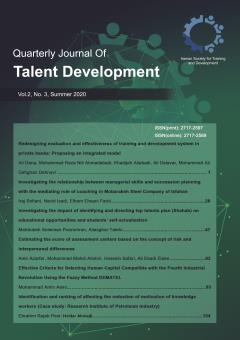Redesigning Evaluation and Effectiveness in the Training and Development System of Private Banks: Proposing an Integrated Model
Subject Areas : New theories and models of human resource training and developmentدکتر علی دانا 1 , Mohammadreza Nili Ahmadabadi 2 , Khadijeh Aliabadi 3 , Ali Delavar 4 , Mohammadali Dehghan Dehnavi 5
1 -
2 - Allameh Tabataba’I University
3 - Allameh Tabataba’I University
4 - استاد گروه سنجش و اندازهگیری دانشگاه علامه طباطبائی، تهران، ایران.
5 - Allameh Tabataba’I University
Keywords: Training &, Development EvaluationEffectiveness Training Evaluation Private Banks,
Abstract :
The purpose of this study was to study the evaluation and effectiveness system in private banks in order to propose an integrated model for evaluation and effectiveness in private banks. The present study was carried out mixed method. In the qualitative section, the inductive content analysis method was used and a quantitative part of the survey design was used. The statistical population of this study was all employees of the Private Banking in Training and Development unit, and training and development experts who were selected randomly in a randomized, non-randomized, simple and descriptive manner. A semi-structured interview and a researcher-made questionnaire were used to collect data. Validity and reliability of the tools used in the research were confirmed. Also, for analyzing qualitative data, Graneheim and Lundman's method was used and for analyzing quantitative data one sample T test was used. The results showed that the evaluation and effectiveness system in private banks is not well-suited and it is not done in a coherent, organized and integrated way. The findings also showed that the components of the integrated evaluation and effectiveness model of training and development can be classified into 8 main categories. Finally, the results showed that the proposed model is valid from the perspective of experts.
Edwards JS. Factors affecting training transfer in supervisors and hourly employees in a manufacturing organization [PhD Thesis]. [Lismore]. Southern Cross University; 2013.
Mahdavi, Z., Fayyaz, I. Identifying the Effective Factors in Effectiveness of the On-the-Job Training Courses for Presenting the Structural Model. Educational Psychology, 2014; 10(32): 115-137.
Youzbashi A. Investigating the Effective Factors on Improving the Effectiveness of training Courses of National Iranian Oil Company and Providing Appropriate Training Effectiveness Model [MA dissertation]. [Tehran]. Faculty of Psychology and Educational Sciences. University of Tehran; 2010.
Mohammadpour Zarandi H, Taghavifard SM. Calculation the Return on Investment Rate (ROI) of the Specialized Courses of Tehran Municipality. Journal of Urban Economics and Management. 2014 Dec 10;2(8):1-6.
Sepeng S, Miruka CO. Transfer of Learning Challenges Experienced by Employees in Selected Departments of the North West Province. In Proceedings of 8th Annual London Business Research Conference 2013 Jul.
Abili K, Kharrazi S K, Sobhaninejad M, Youzbashi A. Developing an Effective Model of Learning Transfer in order to Return on Investment in the Development of Human Resources Emphasizing on Urban Management, Journal of Urban Economics and Management, 2015;3 (11):79-98.
Kirkpatrick DL. Implementing the four levels: A practical guide for effective evaluation of training programs: Easyread super large 24pt edition. ReadHowYouWant. com; 2009 Jan 28.
Phillips JJ, Brantley W, Phillips PP. Project management ROI: A step-by-step guide for measuring the impact and ROI for projects. John Wiley & Sons; 2011 Sep 20.
Holton E. Implementing evidence-based practices: Time for a national movement? Human Resource Development Review, 2004; 3(3):187–198.
Khorasani A. Doosti H. Measuring training effectiveness in organizations (operational guideline). Industrial research & training center of Iran publisher. Tehran. 2012.
Taheri M. Designing an Operating Training Model: A Study Based on Grounded Theory, Quarterly Journal of Training & Development of Human Resources, 2016; 3(9): 137-161.
Abtahi SS, Jafarinia S. Designing an Effectiveness Measurement Model for Educational Systems. Journal of Research in Human Resources Management, 2009; 1(4): 25-46.
Bakhtiari Y., Kiyanimanesh K. Educational evaluation patterns (emphasizing on modern and applied experiences), Tammadon Elmi Publications, Tehran, 2014.
Hojjati H, Mehralizadeh Y, Farhadirad H, Alostany S, Aghamolaei M. Assessing the effectiveness of training outcome based on Kirkpatrick model: case study. Quarterly Journal of Nursing Management, 2013; 2(3):35-42.
Hall B. LeCavalier, J. The case for level 3. ASTD Learning Circuits. 2000. [Online] Available at: http://www. learning circuits. org/nov2000/hall. html.
Debra PE, Berge ZL. Evaluation and eLearning. Turkish Online Journal of Distance Education. 2006;7(1):124-31.
Khorasani A. Rashtiani B. A holistic approach to training effectiveness (practical guide for implementing of ROI). Industrial research & training center of Iran publisher. Tehran. 2012.
Jafari, M. Quality service training courses for managers and commanders of the police. The Quarterly Management on Police Training, 2015; 1394(29): 1-22.
Graneheim UH, Lundman B. Qualitative content analysis in nursing research: concepts, procedures and measures to achieve trustworthiness. Nurse education today. 2004 Feb 1;24(2):105-12.


